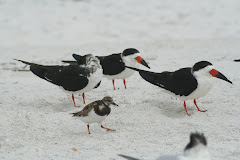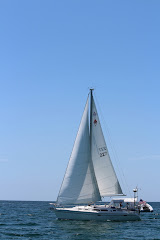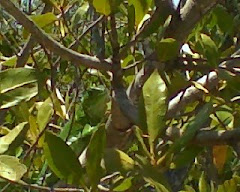A Month without an “R”
It took a series of rain squalls – we’ve had such perfect weather, interesting towns to explore, beaches to walk and winds for sailing, that we’ve haven’t sat down, until now - to write a new post. We have lots to share.
As northerners, we always heard that raw oysters shouldn’t be consumed in a month without an “R”. Floridians seem to have no such limit. To most of us who enjoy raw oysters on the half shell, Apalachicola oysters are the “gold standard”. Nearby St. George Sound has the largest beds in Florida; they have a sweet mild flavor that can be slightly enhanced by a little cocktail sauce laced with horseradish sauce. They were as perfect on May 2nd, 6th, 7th and 9th as in any month with an “R”. The industry is larger than we imagined. Oysters processing houses line a quarter mile of Scipio Creek; tons (10% of the US market) are shipped whole and live in bags as well as shucked and shipped in various size fresh cold containers. We discovered the enormity of the volume on our biking excursion around Apalachicola. We saw 30-foot mountains of shells being fronted loaded aboard 100 foot a flat deck barge. The shells are taken out to help form new oyster beds by giving the spawn a place to attach and grow.
Apalachicola is usually a one-night stop on our way to the southwest Florida Peninsula of Florida (Clearwater). This trip we toured the community on our “boat bikes” visiting museums, old homes, seafood shops and an ice cream soda fountain.
Did you know that the first patent in 1851 for inventing an air conditioning machine was granted to Dr. John Gorrie? His discovery occurred when he wanted to cool the air in the of the Apalachicola Yellow Fever patients’ sick rooms. Apalachicola and Port St. Joe both experience epidemics in the 1840’s. In Port St. Joe 80% of the population was wiped out. The State Park Service has an exhibit in his former home featuring the operational machine invented, along with an excellent historical panorama.
The Orman House located on as high a hill as exists along the Apalachicola River is now operated as a State Park/Museum. Our Ranger guide gave us one of the best historical overviews of the evolution of the area. “When Cotton was King” the river provided the transportation for the Georgia grown cotton to the harbor and Orman’s many cotton warehouses. From there they were loaded on to ships in St. George’s Sound for transshipment to Savannah. The prosperity connected with the cotton trade ended after the Civil War as railroads were built and provided quicker more efficient transport to southern textile mills and Atlantic Sea ports. Logs from the impenetrable forest were sent down the river for milling and shipment. That industry and the canning and freezing of Seafood packaging allowing distribution eventually sustained the area, which is often called the “Forgotten Coast”.
Our three-boat flotilla enjoyed spotting the oystermen as we headed east through St. George’s Sound/Bay to the eastern end of the Gulf Coast barrier islands-Dog Island. Rafting up in a well protected bay surrounded by grass beds make it possible for only one anchor down and thus only one anchor, when weighted, was muddy and mucky. Clean up was a two-stage chore, 1st aboard with the wash down pump and 2nd when we hauled 160 feet of chain out of the anchor locker later and rewashed at the marina. The Rustic homes along the beach are built on high stilts and sit tucked behind the sand dunes. Clusters of shorebirds included Sanderlings, Willets, Ruddy Turnstones and 3 kinds of terns, Royal, Sandwich and Least occupied the beach. The surrounding shallow depth, grass beds were the perfect spots for John to take the dingy and fish. The fishing turned into catching – two nice spotted trout- making a terrific dinner for the Zephyrina crew.
From Dog Island we began our return journey. A night in Apalachicola gave us the opportunity to enjoy an oyster and shrimp dinner at “Up the Creek”.
Though we are retracing our coastal route we have deviated to check out Crooked Island, an excellent anchorage via a narrow channel on property near the Tyndall Air Force Range. Sailing close to the wind we raced west to the Panama City’s Harbor Channel. After bucking the out going current we ducked behind the barrier island, Shell Island, to anchor/raft up. An early morning beach walk on crystal white sands was another reminder of why we love sailing – the lovely natural places we can enjoy. Sea Shell and its crew, John & Kay Sheehan had left after morning coffee, to take the ICW route back home. Sea Shell’s shorter mast allows passage under the less than 50’ bridges.
Given a forecast of afternoon thunderstorms the St. Andrews Municipal Marina was our next stop. After tie up on the lay along dock, we found Ernie’s Oyster Bar and Brew House for sustenance and libation.
The rain has washed off the salt from Zephyrina’s hull. Now Arkeoo’s crew, Connie & Wally, will join us analysis the wind forecast and plan our over night sail to Pensacola.
Thursday, May 10, 2012
Subscribe to:
Post Comments (Atom)











































































No comments:
Post a Comment